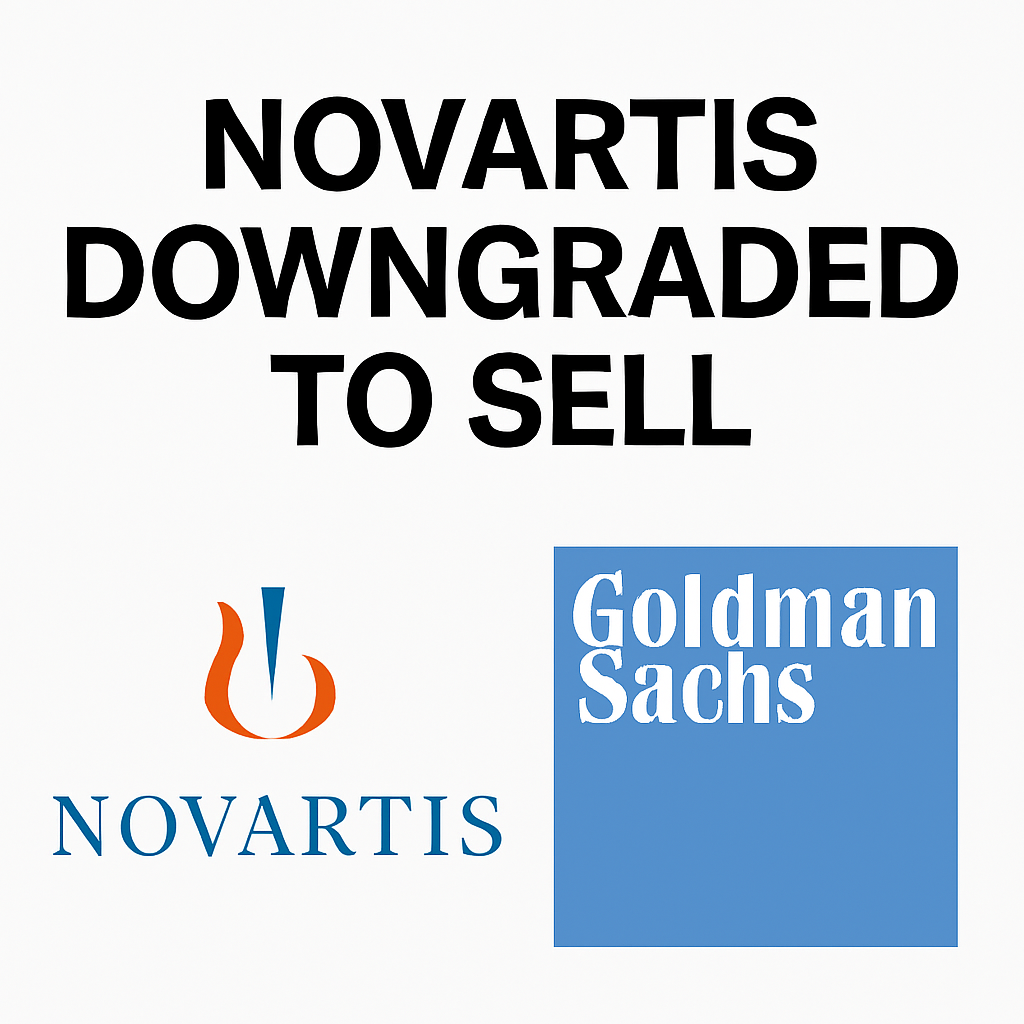
In a bold move that rattled investors, Goldman Sachs downgraded Novartis (SIX:NOVN) from “Neutral” to “Sell” on September 12, 2025, citing mounting risks that are not reflected in the stock’s current valuation. The downgrade comes after a period of strong performance for the Swiss pharmaceutical giant, which saw its shares climb to record highs in late August, buoyed by share buybacks and earnings momentum.
📉 Price Target and Valuation Concerns
Goldman Sachs revised its 12-month price target for Novartis’ Swiss-listed shares to CHF94, down from CHF95, representing an 8% downside from the previous close of CHF101.78. For the U.S.-listed ADR (NYSE:NVS), the target was cut to $118 from $119, implying a 7.6% downside from $127.70.
At the heart of the downgrade is valuation. Novartis currently trades at approximately 14x projected 2026 earnings—a 7% premium to the European biopharma sector and a 10% PEG premium. Goldman analysts argue that this valuation is unjustified given the structural headwinds facing the company.
💊 Entresto Generics: A Major Threat
One of the most pressing concerns is the rapid erosion of market share for Novartis’ blockbuster heart failure drug, Entresto. Since the launch of generics in the U.S. at the end of July 2025, fourteen competitors—led by Indian firms like Ascend Laboratories, Novadoz Pharmaceuticals, and Zydus—have entered the market. These generics have already captured 35% market share by late August, offering discounts ranging from 15% to 67% below Novartis’ wholesale acquisition cost.
Goldman projects Entresto’s U.S. sales will decline by 14% in 2025, with an 80% plunge expected in Q4 alone. Gross margins are forecast to compress from 80% in 2024 to just 50% by 2027, significantly impacting profitability.
🚨 Loss-of-Exclusivity (LoE) Risks
Beyond Entresto, Novartis faces a broader challenge: loss of exclusivity across its portfolio. Goldman estimates that approximately $41 billion in peak sales are at risk through 2036. Key drugs facing LoE include:
- Cosentyx – 2029
- Kisqali – 2031
- Kesimpta – 2031
While Novartis’ Phase 2 and Phase 3 pipeline represents $44 billion in potential peak sales, risk-adjusted estimates shrink that figure to just $19 billion. This imbalance between at-risk revenue and pipeline potential is a major concern for long-term growth.
📊 Slowing Growth Outlook
Goldman Sachs forecasts a sharp deceleration in Novartis’ revenue growth. After several years of high-single-digit and low-double-digit gains, growth is expected to slow to just 2% in 2026, remain in the mid-single digits through 2029, and turn negative from 2030 onward.
“While we can understand the reasons for the outperformance vs. peers over the past few years, we do not believe that the current multiple adequately reflects the forward risks,” Goldman analysts noted in their report.
📉 Market Reaction and Analyst Sentiment
Following the downgrade, Novartis shares fell 2.3% in early trading. The sentiment among analysts remains mixed. According to GuruFocus, the average one-year price target for Novartis is $118.30, with a high estimate of $134 and a low of $100. The consensus recommendation from eight brokerage firms currently stands at 3.3, indicating a “Hold” rating.
Goldman’s downgrade adds weight to concerns about Novartis’ ability to sustain its valuation premium in the absence of near-term catalysts. The firm also noted that the effects of the company’s $15 billion share buyback program—launched in July 2023—are likely already priced in, limiting upside potential.
📢 Social Media Reaction
Investor sentiment on social media has been swift and polarized. Some see the downgrade as overdue, while others argue that Novartis’ pipeline and global footprint remain undervalued. Here’s a relevant post from X (formerly Twitter):
Goldman Sachs downgrades $NVS to SELL. Entresto generics already eating market share. Valuation premium no longer justified. Pipeline risk-adjusted = weak. Time to reassess. #Novartis #PharmaStocks — MarketLens (@MarketLensAI) September 12, 2025
🔍 Strategic Implications
For long-term investors, the downgrade raises critical questions about Novartis’ ability to navigate patent cliffs, generic erosion, and a muted innovation pipeline. While drugs like Kisqali and Scemblix offer some growth potential, they may not be enough to offset the looming revenue declines.
Moreover, the company’s reliance on buybacks to support share price performance could face diminishing returns. Without fresh catalysts or breakthrough therapies, Novartis may struggle to justify its valuation premium.
📌 Conclusion
Goldman Sachs’ downgrade of Novartis to “Sell” is more than a valuation call—it’s a warning about structural risks that could reshape the company’s growth trajectory. With generics biting into flagship products and pipeline uncertainty looming, investors may need to reassess their exposure to the stock.
For further details, you can read the full analyst note on Investing.com or explore analyst consensus on GuruFocus.
u3avmd
DzpnjKOJXNHekuRny